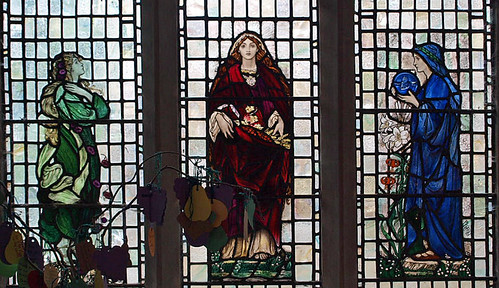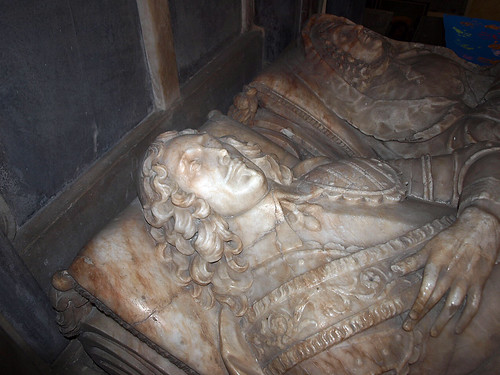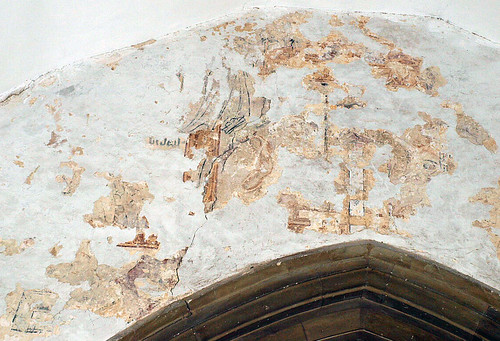ALL SAINTS. Perp W tower with spire. Of the dormer windows the upper tiers C19. Chancel largely rebuilt. The E window of five lights with flowing tracery, i.e. c. 1320-40,* the side windows also Dec. The best piece of architecture is the S transept, c. 1340 with all three windows (W, S, E) of four lights and with busy small-scale flowing tracery. The angle to the S aisle has a small two-light window high up set at an angle, probably to give light to the pulpit. S doorway and S aisle windows Dec., N aisle also. The arcade of four bays Early Perp with octagonal piers and wave-moulded arches. Chancel arch Perp, and curious wide blank arches surrounding the N windows of the chancel. Sedilia and Piscina with three thin ogee arches. In the S transept, entirely in keeping with the ornate style of the windows, a diagonally placed sculpture-niche in the SE corner. The aisle roofs form a continuation of the nave roof, slightly more splayed (Crossley). - FONT. An exceptionally interesting example of the octagonal Perp type. The bowl has on its eight sides eight different fanciful varieties of quite plain motifs of Perp tracery, one with an ogee arch, one with quarte-foils, one with trefoil niches under arches, two with a band of crenellation half-way up, and so on. - PEW. In the N aisle. With a frieze of Early Renaissance ornament typical of c. 1540-50. - MONUMENT. Sir Thomas Hatton d. 1658, by E. Marshall (Mrs Esdaile). The tomb-chest stands at r. angles to the E wall of the S transept. On it the well carved recumbent figures of Sir Thomas and Lady Hatton. Against the long sides of the tomb-chest, carved in the round, kneel the figures of their children. The back against the transept wall has a proper reredos, segmental pediment etc. and ornamental motifs, no longer Jacobean but classical, i.e. garlands, big corbels, corbels with cherubs’ heads etc.
* The window seems original, though it is not shown in Cole’s drawing.
LONG STANTON. Off the Roman road from Godmanchester to Cambridge, it is long enough to have two parishes, each with a church of its own.
By a charming group of thatched cottages and an old windmill that has lost its sails stands the simple church of St Michael, framed in chestnuts and roofed with thatch above the nave. A 15th century porch brings us to the great stone arcades two centuries older. One of the windows in the chancel has a little old glass in black and white, but the chancel itself was made new last century. The treasure of the church is a fine oak chest with two roundels on the front. It was a centenarian long before Thomas Burgoyne knew this church; he was its patron in the 15th century, and the chest has a brass plate to his memory.
The noble church of All Saints has been. much changed but its tower and spire are 15th century, the nave arcades are 14th, and a 15th century arch opens into an older chancel made new. A niche in the wall is perhaps the oldest thing in the church, 13th century. The very fine font is 600 years old, elaborately carved with pinnacles.
There is an old box-pew of the 18th century which was used by the Hattons, who bought the manor from Queen Elizabeth and were here during three centuries. They turned the transept into their chapel, and on an elaborate tomb lie the alabaster figures of Sir Thomas and his wife with six sons and daughters kneeling round them, all dressed as in the days of the Commonwealth. The father has long curling hair and is in rich armour; the mother, with a hound at her feet, has a bead bracelet, a kerchief round her head, and holds her handkerchief and a book. The manor passed to the Hattons after Elizabeth seized it from Bishop Cox, the first Protestant Bishop of Ely. It was not all the queen took from him, and the story goes that when the poor bishop was driven to complain the imperious Elizabeth retorted, “Proud priest I made you and I will unmake you.”
Flickr.
By a charming group of thatched cottages and an old windmill that has lost its sails stands the simple church of St Michael, framed in chestnuts and roofed with thatch above the nave. A 15th century porch brings us to the great stone arcades two centuries older. One of the windows in the chancel has a little old glass in black and white, but the chancel itself was made new last century. The treasure of the church is a fine oak chest with two roundels on the front. It was a centenarian long before Thomas Burgoyne knew this church; he was its patron in the 15th century, and the chest has a brass plate to his memory.
The noble church of All Saints has been. much changed but its tower and spire are 15th century, the nave arcades are 14th, and a 15th century arch opens into an older chancel made new. A niche in the wall is perhaps the oldest thing in the church, 13th century. The very fine font is 600 years old, elaborately carved with pinnacles.
There is an old box-pew of the 18th century which was used by the Hattons, who bought the manor from Queen Elizabeth and were here during three centuries. They turned the transept into their chapel, and on an elaborate tomb lie the alabaster figures of Sir Thomas and his wife with six sons and daughters kneeling round them, all dressed as in the days of the Commonwealth. The father has long curling hair and is in rich armour; the mother, with a hound at her feet, has a bead bracelet, a kerchief round her head, and holds her handkerchief and a book. The manor passed to the Hattons after Elizabeth seized it from Bishop Cox, the first Protestant Bishop of Ely. It was not all the queen took from him, and the story goes that when the poor bishop was driven to complain the imperious Elizabeth retorted, “Proud priest I made you and I will unmake you.”
Flickr.



No comments:
Post a Comment